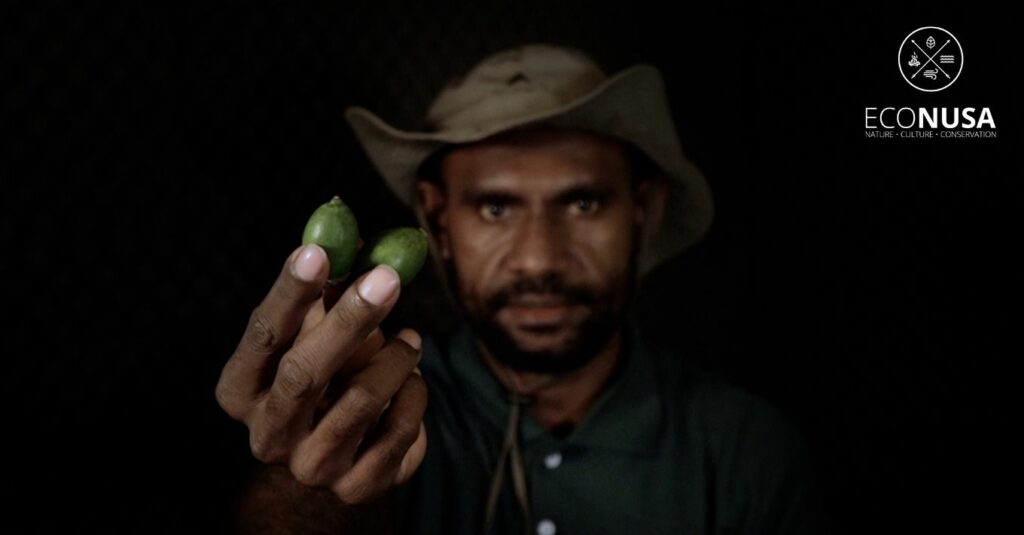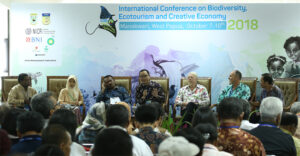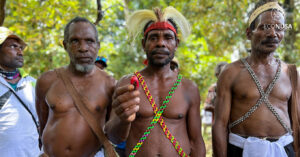
The culture of chewing areca nuts (menginang) is inherent among the people’s life of Tanah Papua, especially those who live close to the coast. Even though this custom is widely practiced by people in other areas, in Papua menginang should not be missed. Usually, it is only the elderly people who do menginang in other areas. However, in the land of Papua, many people of all ages, ranging from children, teenagers, to adults, do this as their daily habit.
A study states that the Papuan people believe that menginang is good for health as it provides many benefits which are good for digestion, strengthen teeth, eliminate bad breath, and can help detoxification. Young areca nuts are also considered to shrink the uterus after giving birth and increase male stamina. Even the content of cholinergic in areca nuts is believed to be healthy and makes the body fit.
“Areca nut is like a staple food for Papuans. Every morning, afternoon, evening, night, until you want to sleep, people chew areca nuts,” said Christine Sanggenafa, the lecturer of Social Anthropology of the University of Papua in MACE Papua and Maluku, entitled The Potential of Areca Nut: From Tradition to Ready for Export on November 30, 2022 virtually.
Read also: Keerom Regent Proclaiming Cultivation of Batara Betel Nut
Areca nuts have a sweet-sour sensation like the taste of toothpaste. Some Papuan people even say that there is no other food or spice that can match the taste of areca nut.
Usually areca nuts are chewed together with lime flour which is made from crushed clam shells. Lime flour serves to reduce the sour and bitter taste that comes from areca sap. Betel stems are also often eaten with areca nuts to neutralize the bitter taste of areca nuts.
The Land of Papua is also known as “the Country of Areca Nut”, because the areca nut reflects the identity of the Papuan people. It is also a symbol of solidarity and brotherhood. Betel and areca nut are always present at every meeting or traditional ceremony in the Land of Papua. Areca nut is a mandatory item that must be there since it plays an important role as an icebreaker and makes the awkward feeling away in conversation. Menginang is also a means for socializing and “opening” interactions between one person and another. For the newcomers, menginang with native Papuans implies a willingness to get to know each other better and become part of the family.
Read also: Pili Nut, Shade Tree as the Source of Livelihood
Areca nut is a fruit that comes from the palm family (Arecaceae) which grows in the Pacific, Asia, and eastern Africa. Areca palm trees can grow on the ground to a height of 1,400 meters above sea level. Several types of areca nuts in Papua are Areca catechu, Areca mandacanii, Areca unipa, and the most recently discovered, Areca jokowi.
Apart from fulfilling the consumption needs of the people in the Land of Papua, areca nut is also a leading plantation commodity with high potential to be pushed into the global market. This is a generation-to-generation business of the indigenous Papuan people, especially in Skouw Sae, Skouw Yambe, Skouw Mabo, and Holtekamp, in Papua Province. “Areca nut has created economic value in Papua. Now we will focus on developing Areca catechu to the export market,” said Karel Yarangga, Head of the Agriculture and Food Service Office of Papua Province.
Apart from being closely related to the culture of the Land of Papua, areca nut also plays a major role in supporting the economy and social community. Therefore, it is very important for us to support and maintain the preservation of this plant, as well as the culture of menginang. Because protecting areca nuts is the same as protecting the culture as the identity of the indigenous Papuan people.
Editor: Leo Wahyudi







